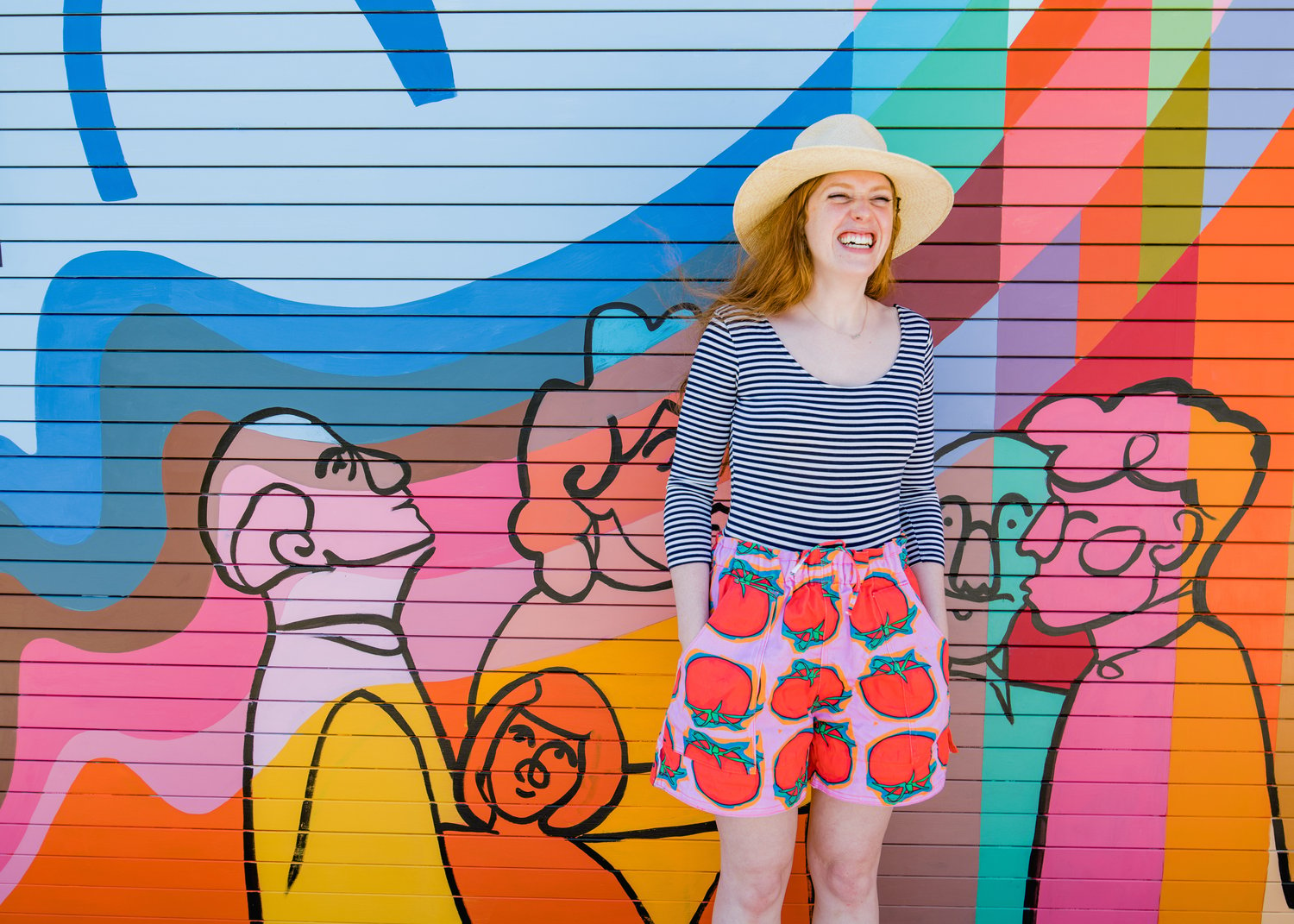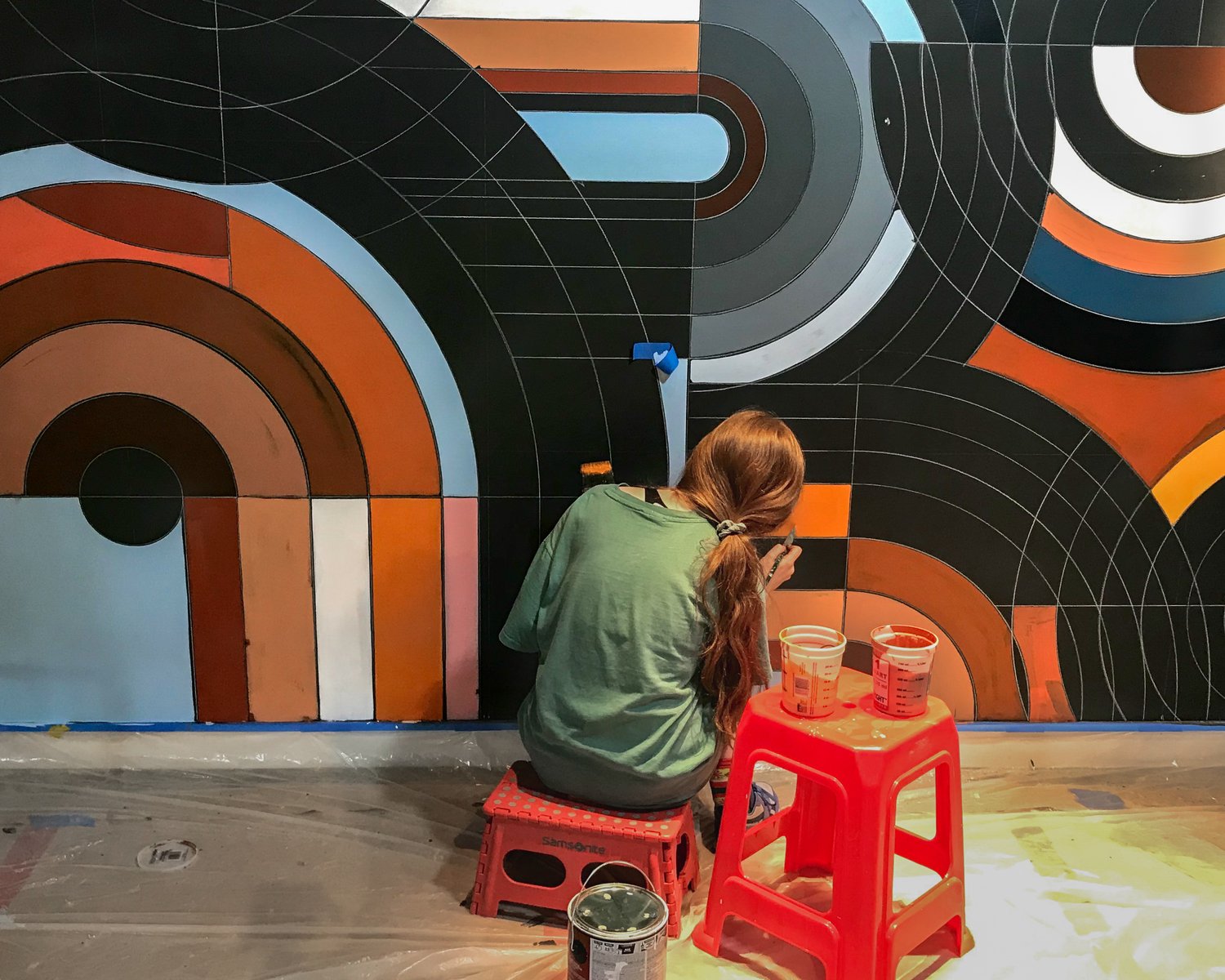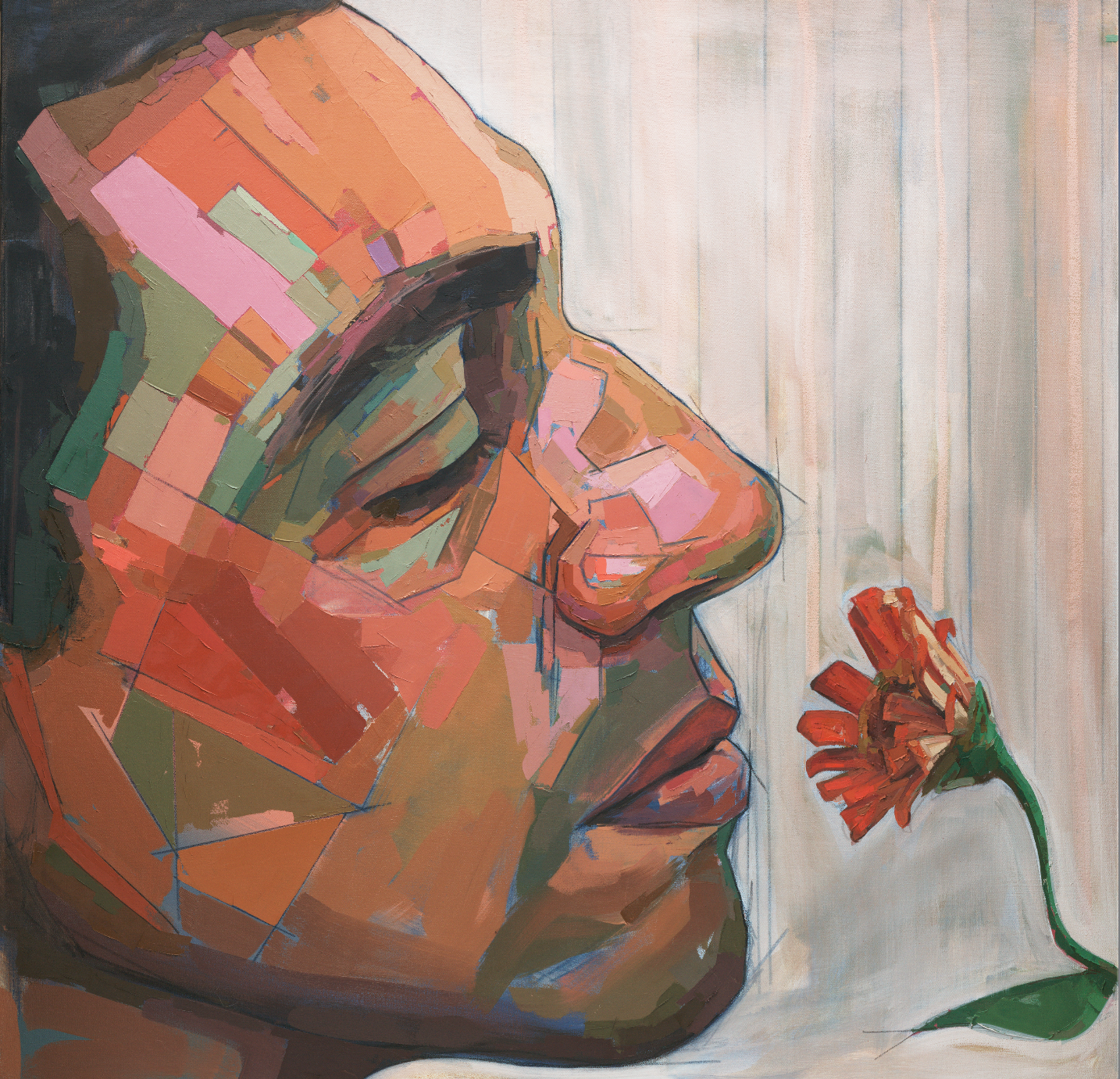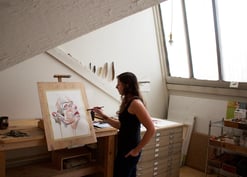Through a diverse body of work spanning multiple mediums and themes, TurningArtist Mia Cross explores color, the human figure, and narrative. Her oil paintings and murals demonstrate a fixed fascination with patterns and a love for color. When painting, Cross pays special care to create engaging color relationships, sometimes harmonious and sometimes dissonant. She stitches her colors together like a quilt, often laying them down with a palette knife and leaving them untouched for the remainder of the painting process.
Can you tell us about your process?
My process typically begins with a lingering feeling or thought. Sometimes I draw it down in a flurry, just to get it out of my head. Then I return to it a couple of days or weeks later, and if it still feels exciting, I start crafting the composition. For mural work, I always create a digital sketch. Often I will do that for my oil paintings as well so I can try out different colors, patterns, or placements. Then I get to painting! For my oil work, I usually let the layers dry between working on it, so I will return to a piece over the course of several weeks until it is complete.
Can you tell us about your journey to becoming a professional artist?
After graduating from BU in 2014, I worked some unfulfilling retail jobs while looking for work as a display artist. About a year after graduating, I was hired as a display artist and quickly found I didn’t like it at all. I realized that I wanted to be creating my own work so I moved home and started to grow my portfolio and apply to shows while working part-time for another artist. After receiving enough commission work and a Blanche Colman grant, I decided to leave my part-time job and dove into working as an artist full time (2016-ish). When you are looking for inspiration, what resources do you turn to?
When you are looking for inspiration, what resources do you turn to?
Oh, I am always looking for inspiration! Or not even looking, just existing, living, and everything happens to be inspiring if you let it. I will look to artists I admire in both books and online. I look to nature. I look at colors. I look at old stuff. I listen to podcasts and music.
Walk us through a typical day in your studio. What is your routine? Has it changed in the past year?
Well, I wish I could be in the studio every day but often I balance it with being onsite for murals, meetings/calls, transporting my work, and focusing on the business/marketing/sharing side of things. But an ideal studio day would be first to exercise, then eat breakfast, and get into the studio by 10. Listen to music, paint, take some breaks when I need them, paint some more. Have lunch, maybe go for a walk, and keep painting until the night maybe until 6 or 7. That’s a good day! Finding the right rhythm to be productive in the studio can be a challenge, what advice do you have for staying productive and focused?
Finding the right rhythm to be productive in the studio can be a challenge, what advice do you have for staying productive and focused?
I think it is important to be kind to yourself and listen to your body. Take breaks and don’t force it. Find a routine that works best for you. If you are not excited about the work you are making it will be harder to stay focused. Explore and make work that makes you happy! For example, I sort of work in waves of intensity, really bucking down with long days before an exhibit and that works well for me.
What advice do you have for combating creative block?
Read a book or go to a museum. Or go for a walk! Listen to music. See your friends and family. Travel. Do other things that you enjoy. Revisit older work and ask yourself what you think was successful or enjoyed about it.
As an artist, how do you measure success? Can you recall a specific event in your career that made you feel successful?
Hmm, that is a difficult question! Success to me is maintaining my happiness, living and working as an artist, and continuing to learn and grow within my practice. Having or creating opportunities that excite and inspire me, making new work that stretches or challenges me is important to me. Also, having opportunities to share my work, preferably presenting my work in a physical space as opposed to online is critical. The first time I felt successful within my art career was probably in the first grade when my school hung our work up at the public library. It felt so special that people might want to see what I made! And many other moments after that, like hearing that my work made someone happy. Practically speaking, when I paid off my student loans while working as an artist that felt really good because what felt impossible a couple of years before slowly became a reality. For me, that was tied to financial freedom and thus growth and the opportunity to look ahead. And I think having a piece purchased for the permanent collection of the Danforth Museum felt like a success. To be hung on a wall with other artists you admire, artists who have passed but still live on through their work is a really cool feeling. And it’s almost like a sigh of relief, like ok this piece will be safe in this institution and continue to be viewed for however many years without me having to organize a show, etc. And then most recently, building my studio in my new old home is a success. Because it is the biggest investment I’ve made in my career and once again, it once felt impossible and now woohoo I have a place to create that is all my own! But every year that I continue to live as an artist feels like a success.  How do you see the art market changing? Where you do see yourself in this transition?
How do you see the art market changing? Where you do see yourself in this transition?
I feel very lucky to have started my career at a time where art is accessible to millions of people if they seek it out. There is more transparency since so much information is available online. I think that galleries and art advisors will remain valuable and important connectors between people, but I also appreciate that collectors can easily reach out to the artist to learn more about their work, share their work, or support them. I see myself going with the flow, but never fully giving up the business side of my career.
What advice do you have for artists who are beginning to build their careers? Have there been any habits or strategies that you have adopted that you feel have created more opportunities or visibility for your work?
My advice would be to make work you are proud of and want to share. Invest your time in making the art first and then focus on sharing it, exhibiting it, etc as the next step. I tell artists starting out how important it is to have an online presence. That is the reality of how a lot of content is shared now. And don’t be afraid to ask questions! Be stubborn, and follow your happiness. Share your goals because you never know who might help you along the way. I think every show or person I have met has led to the next thing, even if I didn’t realize it at the time. I have had people email me “Oh I saw your work five years ago at a coffee shop and now I have a house and want to buy a piece”. You never know!
Do you consider yourself, and all artists, to be entrepreneurs? Why or why not?
I definitely consider myself to be an artist and entrepreneur. I don’t think every artist is an entrepreneur though; some wildly talented people do not have the chops or time or interest in growing their art as their business or even sharing it. But those who have to balance running their own business and their craft, yes! I am the maker, the marketer, the website creator, the photographer, the art handler, the customer service rep, and the assistant to myself! Of course, many people take on roles in different capacities throughout my career but at the core, you have to continue to be the driver (unless you are dead and really famous and have a foundation which is great too, then other people can do the work while you sleep).
Failure is an inevitable part of success in any field. Do you have advice for overcoming setbacks?
Setbacks should just be fuel under your bum. Or a time to pivot (if you want to). A time to believe in yourself and try again. You can take the same road or try another route. I don’t think I’ve viewed anything in my career as a setback though, even denials, etc. I just view it as not the right time, not the right fit. There are so many factors out of your control. What you can control is trying again and not giving up on yourself. What sparked your interest in partnering with TurningArt?
What sparked your interest in partnering with TurningArt?
TurningArt brought me into one of the biggest projects of my career so far. They made me value my work and time in a whole new way. They were with me every step of the way to make sure that I could focus on the making side of things. After hustling on so many projects in the past about the “when, where, and hows”, it was such a relief to have a team of people who had my back!
What does having your artwork in the workplace and other commercial or public spaces mean to you?
It is special to share my work in a space that is utilized by what could be hundreds of people every day. To be a part of someone’s environment, to have possibly positively affected someone’s day through my art makes me happy. I think that workplaces, commercial or public spaces that invest in supporting the arts are investing in not only the artist but also their community. It is a way of showing they care, like giving a gift to people’s eyes! By providing a wall or space for art, you are opening up a whole new world!
To see more featured TurningArtists, return to our blog. To get Cross's art in your space, set up a free consultation with an Art Advisor here!




.jpg?width=332&height=177&name=%E6%A9%983-2%20(1).jpg)

